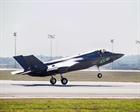The Royal Navy's third prototype F-35 delivered
This is ZM137, lifting off the tarmac at Naval Air Station Fort Worth in Texas – next to the huge Lockheed Martin works which builds the F35 Lightning II.
The front-line version of the F35 – also known as the Joint Strike Fighter – will be the principal weapon of HMS Queen Elizabeth and Prince of Wales from the end of this decade.
Lockheed’s chief F35 test pilot Alan Norman took the stealth fighter up for a short test flight before bringing it back safely on to Texan soil.
After a series of further test flights and checks by both Lockheed and the MOD, the trials variant will join its two older sisters, ZM135 and ZM136, at Eglin Air Force Base in Florida; they were handed over to the UK last year.
All three F35Bs – the jump-jet version of the fighter; F35A is a land-based version, while the F35C is the ‘cats and traps’ version for use on US Navy carriers – will be used to train pilots and also help maintainers understand how to look after the world’s most advanced combat aircraft.
Around a dozen Fleet Air Arm and RAF maintainers are working at Eglin, plus pilots Lt Cdr Ian Tidball and Sqn Leader Frankie Buchler.
The latter recently became the first British military pilot to fly an F35 after undergoing conversion training with the US Marines Fighter Attack Training Squadron (VMFAT-501).
Lt Cdr Tidball, a veteran Sea Harrier pilot with 1,300 hours in the cockpit of the legendary jump jet, is due to become the first Fleet Air Arm aviator to take an F35 aloft in the next few weeks.
Once training at Eglin is completed – probably next year – the British team is due to decamp from Florida to Edwards Air Force Base in California where, having learned how to fly the F35, they carry out operational tests to prepare it for front-line service.
The Fleet Air Arm and Royal Air Force are due to start receiving front-line F35s in 2016, operating out of RAF Marham, near King’s Lynn, where land-based testing and training flights will continue through 2017. The first test flights from HMS Queen Elizabeth are planned in 2018.

